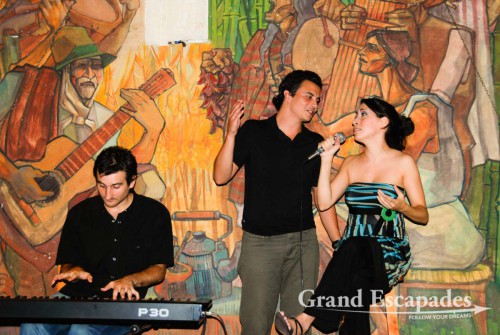
La Pena del Colorado was one of the places we went with the Spanish school. There, singer Noelia Moncada introduced us to “Música de folclórica Argentina, Latinoamericana y ciudadana”. This show was absolutely fantastic! Buenos Aires, Argentina
Heidi could not wait to learn all about Argentina’s specific pronunciation, especially the one of Buenos Aires. So she spent her afternoons at Buespanish, a language institute, which she can highly recommend: www.buespanish.com.ar. They have excellent teaching materials, especially developed for providing foreigners with an insight in Argentine’s culture, geography, a bit of history or simply daily affairs. The staff is really competent and they do the utmost to make your stay in Buenos Aires memorable. On two evenings they took us to places that we would have never found ourselves.
During that time, Gilles just went discovering the city, walking miles and miles in the different parts or “Barrios” to get a better feeling of this place. In the hottest hours of the afternoon, he also enjoyed several times the air-conditioning in movie theatres and watched for the first time in months a few films.
Together with Heidi’s Spanish teacher and a few other students, we spent an evening in “La Viruta” in Palermo, where we watched tango and salsa classes for everybody to join in. This place is amazing, very informal and laid back. Young and old, beginners and very advanced dancers are frequenting the dance classes all day, with evenings and weekends being the busiest time. What surprised us most was how casual the place was: nobody was dressed up, the instructors setting the example. We managed the basic step, enough to realize that tango is not easy to master! There are tables on the side of the big dance floor where you can watch people tango or those trying to do so. A simple rule is: the latter in the evening, the better the dancers. This place was absolutely authentic, far from the usual tango shows in restaurants.
La Pena del Colorado was another place we went with the Spanish school. There, singer Noelia Moncada introduced us to “Música de folclórica Argentina, Latinoamericana y ciudadana”. This show was absolutely fantastic! We both truly enjoyed this music. The public gave a standing ovation to the singer and the musician accompanying her on the piano. Again a very casual environment, without tourists! The food was tasty and presented the cuisine of the northwest. All this we enjoyed for very little money.
The restaurant in Buenos Aires we remember best is La Cabarera, in Palermo. We arrived 30 minutes after it had opened for the evening and the place was packed. So we almost left because we have an aversion against restaurants that are too busy. But being stunned that a restaurant is full at 09:00 pm in Buenos Aires, where this is a ridiculously early time to have dinner, we luckily turned around. Otherwise, Gilles would have missed out on the biggest steak ever served to him. And he did finish it, the 800 to 1.000 gr. T-bone steak, but had to give up on the 14 different sauces that came along!
Lots of time we spent at Cementerio de la Recoleta, where the rich and famous of Argentina have their final resting place: presidents, governors, war heroes, writers and of course “Evita” Peron, although not her husband. They are all buried here, often together with family members. These little palaces come in all shapes and sizes with elaborate decorum or plain crypts and they all have two floors for the extended family. Only families who already have tombs there can bury their beloved ones in Recoleta. No new tombs are available: the place indeed looks cramped.
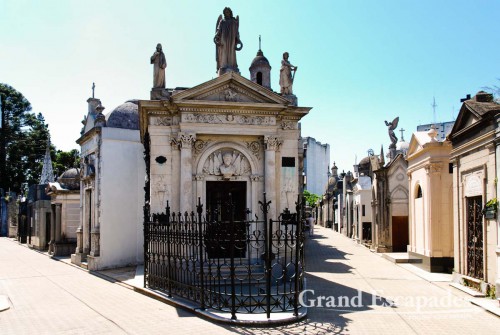
Cementerio de la Recoleta, where the rich and famous of Argentina have their final resting place: presidents, governors, war heroes, writers and of course “Evita” Peron, although not her husband, Buenos Aires, Argentina
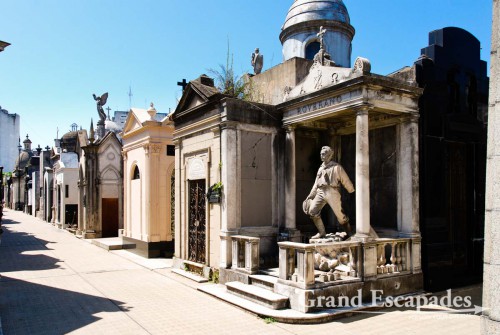
Cementerio de la Recoleta, where the rich and famous of Argentina have their final resting place: presidents, governors, war heroes, writers and of course “Evita” Peron, although not her husband, Buenos Aires, Argentina
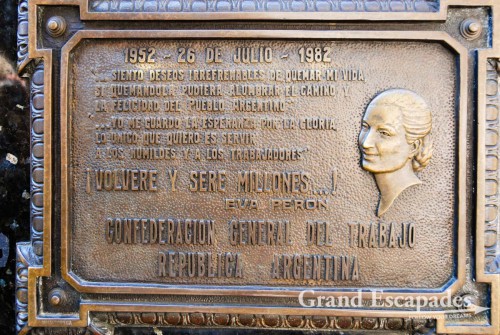
Cementerio de la Recoleta, where the rich and famous of Argentina have their final resting place: presidents, governors, war heroes, writers and of course “Evita” Peron, although not her husband, Buenos Aires, Argentina
The “Museo de Arte Latinoamericano de Buenos Aires” was another highlight, one of Buenos Aires’ most modern museums with an exquisite selection of Latino Americas’ greatest contemporary painters.
On our last day in Buenos Aires, we went down to La Boca and San Telmo. After we spent all night at the carnival in Gualeguaychu, we weakly fought our way through the crowds in San Telmo. Most of the artefacts displayed were extremely kitschy and all of the antique shops that San Telmo is so famous for, were deserted. The next tourist trap we fell in was the “Caminito”, the street in La Boca that is famous for its painted houses. Within this block of houses tourists fill, literally, the streets. This was tourism at its ugliest, although we must confess that it was there that we saw the best Tango and Milongo dancers ever. Outside of this block, La Boca is a pretty rough neighbourhood to put it mildly. The other attraction in this barrio is La Bombonera stadium, the club of once superstar Diego Maradona. There are plenty of shops selling Maradona DVDs, T-shirts, keyrings, not to mention the more than life sized Maradona replicas all around that you can hug, kiss or simply pose next to in order to have your photo taken.
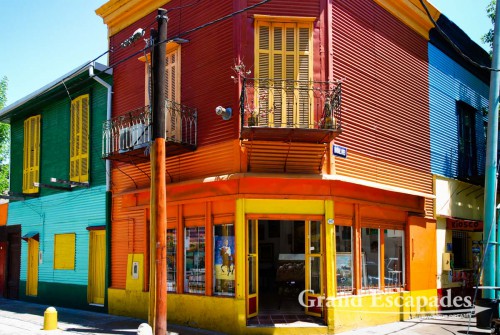
The “Caminito”, the street in La Boca that is famous for its painted houses, Buenos Aires, Argentina, South America
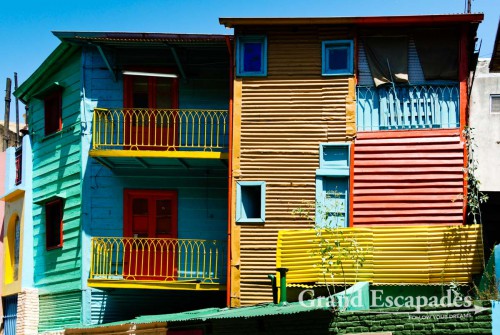
The “Caminito”, the street in La Boca that is famous for its painted houses, Buenos Aires, Argentina, South America
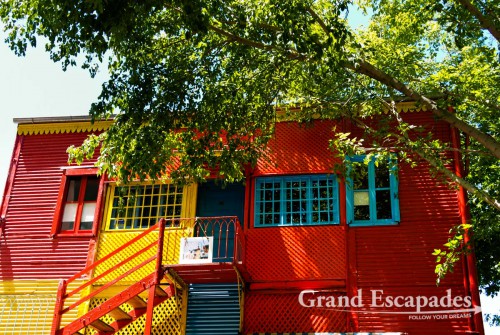
The “Caminito”, the street in La Boca that is famous for its painted houses, Buenos Aires, Argentina, South America
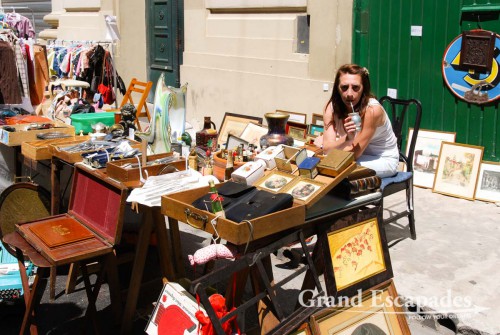
Sunday market at San Telmo – Most of the artefacts displayed were extremely kitschy and all of the antique shops that San Telmo is so famous for, were deserted – Buenos Aires, Argentina
Another aspect of Buenos Aires that Heidi was told about are the “Piqueteros” that stage protests in the city centre every given day, making life for the residents rather difficult, because public transport is constantly interrupted. Needless to say that most of these manifestations are more than justified, like the “Madres de la Plaza del Mayo” who still protest against the disappearing of their sons during the military dictatorship. Apart from those truly motivated people, there are others who are paid by whatever party who wants to be heard. Honestly, we never saw them …

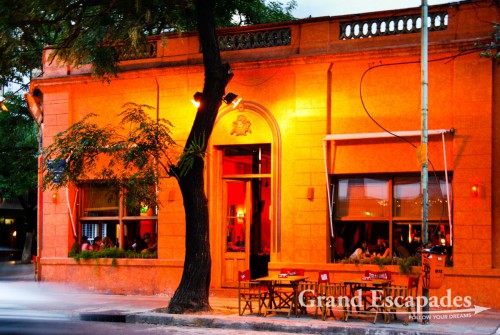
No comments yet.